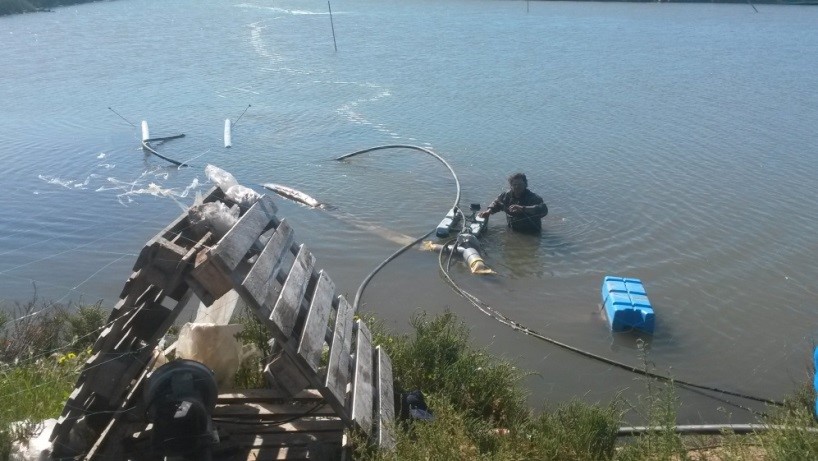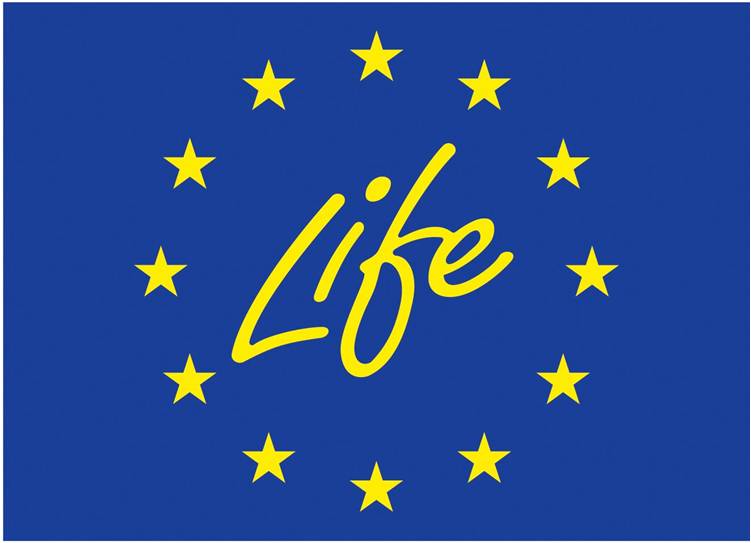ACTION B3: PROOF OF THE BEST OXYGENATION TECHNIQUES IN SALT WATER CULTIVATING TANKS
ACTION B3: PROOF OF THE BEST OXYGENATION TECHNIQUES IN SALT WATER CULTIVATING TANKS
In aquaculture facilities it is very common that the main energy consumption is the one required for the water oxygenation systems. Furthermore, when liquid oxygen is used as feedstock for the oxygenation of water it must be taken into account that this liquid oxygen is produced almost exclusively from the distillation of air, a highly energy demanding process requiring cooling air to cryogenic conditions (in around -180ºC). For these reasons, the impact coming from culture tanks oxygenation in carbon footprint is the second most important in this sector, (when it is obtained though a gas company supply), only behind carbon footprint associated with the production of feed and exceptions, and even ahead of the water pumping systems.
To reduce this environmental impact the following actions are proposed in AQUASEF project:
![]() B.3.1. Developing a detailed study of oxygen consumption of the facility and seasonal consumption.
B.3.1. Developing a detailed study of oxygen consumption of the facility and seasonal consumption.
![]() B.3.2. Installing microbubble generating devices to oxygenate fry rearing tanks
B.3.2. Installing microbubble generating devices to oxygenate fry rearing tanks
![]() B.3.3 Installing high efficiency aerators to oxygenate fish farming tanks
B.3.3 Installing high efficiency aerators to oxygenate fish farming tanks
![]()
Efficiency increase and environmental impact reduction due to the total elimination of liquid oxygen consumption coming from external production. After replacing previous oxygenation equipment Drops & Bubbles will work with atmospheric oxygen in fattening tanks and in fry culture tanks the oxygen produced by electrolysis will be used. Reduced consumption of liquid oxygen is estimated around half a tonne per year, which will turn a significant reduction of GHG emissions.
![]() A report in which all data collected throughout the months of the year will be done, in order to determine the typical oxygen demand and seasonality in common cultivation techniques in coastal saltwater aquaculture.
A report in which all data collected throughout the months of the year will be done, in order to determine the typical oxygen demand and seasonality in common cultivation techniques in coastal saltwater aquaculture.
![]()
The main expected outcome of this task is to provide a fully documented pilot installation, which report on how and when technologies of efficient aeration are feasible in saltwater fattening tanks and technology dissolution of oxygen for fry farming. This will involve a medium-term environmental improvement that will pierce through the technical scope of this project, being tested technologies implemented in many other companies of the sector.
![]() Another result of great interest to the sector will be the report with training material on when and how to incorporate efficient systems and efficient aeration tank designs for microalgae and fish growing.
Another result of great interest to the sector will be the report with training material on when and how to incorporate efficient systems and efficient aeration tank designs for microalgae and fish growing.
This activity main aim is to prove the operation of both ventilation elements developed by Drops & Bubbles Technology (D&BTech) aiming at saving electrical power in the transfer of oxygen both to the pre-fattening tanks and the fattening ponds.
In this second stage of the project, they have been working both on the oxygen diffuser for the fattening sites and the oxygen micro-diffuser for the larvae tanks.
Monitoring of the oxygen diffusers at the fattening stage
Among the actions carried out with the diffuser for the fattening stage, the test on both grills in ponds has been still implemented. New tests on materials and data collection have been carried out.
 |
 |
| Tests on diffuser for fattening stage |
The particular actions carried out during the first semester 2016 have been the following:
- Follow-up visits have been carried out in order to verify the grills conditions after functioning for several weeks. The functioning is satisfactory but a more significant sedimentation than expected has been recorded. Given this incident, it was decided to carry out a second test with other potential building materials.
- When both grills are functioning, the bubbles generated allow an efficient transfer of oxygen, without adding pure oxygen except for the highest sun intensity moments.
- In the second materials test, the impact of natural sedimentation on ABS and polyethylene tanks is being tested instead the PVC, the material for the current ventilation elements.
Monitoring of the MicroBTech diffusers installed in the fries’ cultivating tanks

| MicroBTech diffusers tests |
The particular actions carried out during the first semester 2016 have been the following:
- For the last months, in cooperation with Esteros de Canela staff, the behaviour of both diffusers placed in one of the tanks of the fries site has been monitored.
- The timer valve mentioned in the previous report has recorded a good behaviour when periodically interrupting the oxygen supply and allowing the diffuser membrane to come down and, therefore, the cleaning of obstructive particles.
- An effective reduction in the consumption of pure oxygen is maintained for the fries tanks due to the generation of smaller bubbles with the D&B devices: bubbles are fully transferred to the water mass when going up. Thus, the oxygen contained in the bubbles cannot be freed in the atmosphere.





